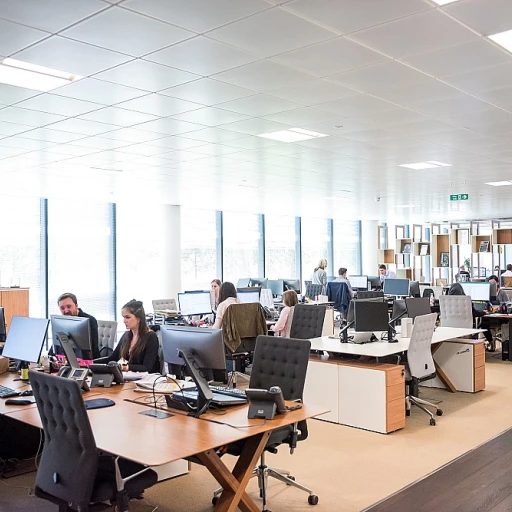
Understanding Quick Changeover in Learning
Grasping the Concept of Swift Transition in Education
Quick changeover, a principle derived from lean manufacturing, fundamentally transforms the landscape of continuous learning. Initially a technique to enhance product quality and minimize changeover times, it's now being harnessed to revolutionize learning methodologies. The crux of this approach lies in the single minute exchange of machine equipment, originally known as SMED (Single Minute Exchange of Die), which enables rapid switches between internal activities and external activities. Similarly, in educational settings, quick changeover encourages the swift transition of learning modules, allowing learners to efficiently switch between different skills or knowledge areas.
Continuous learning thrives on the agility of internal changeover elements being managed effectively, enabling professionals to swiftly update their skill sets. This management process ensures not only time-saving but also the maintenance of high educational standards as learners navigate diverse content without prolonged delays.
The goal of quick changeover in learning is to emulate the lean approach of reducing set times between different learning modules. As with the manufacturing process, effective tools and sound quality management principles equip learners for continuous improvement. This newfound agility in switching learning modules draws parallels with SMED quick strategies in production, optimizing both time and educational outcomes.
The link between quick changeover in learning and lean manufacturing underscores its potential to bolster educational quality, thereby enhancing the product quality of educated professionals. For more insights on novel educational frameworks inspired by such principles, explore antibody-based training as a pathway to continuous learning.
Strategies for Effective Quick Changeover
Effective Strategies for Quick Changeover Implementation
Quick changeover, also known as SMED (Single Minute Exchange of Die), is a crucial strategy in continuous learning and lean manufacturing that focuses on minimizing changeover times between processes. Implementing effective quick changeover strategies can dramatically enhance productivity and product quality in an organization. Here are some pivotal strategies:- Distinguish Between Internal and External Activities: One of the foundational steps in quick changeover is identifying which activities must be performed while the machine is stopped and which can occur externally. Isolating these internal elements and external activities helps streamline the process, reducing downtime significantly.
- Standardize and Simplify: By standardizing procedures, you can simplify the changeover process. This standardization ensures that each step is efficient and repeatable, thus improving overall time management and reducing waste.
- Engage in Continuous Improvement: Lean principles emphasize ongoing improvement, which is why it's essential to continually evaluate changeover processes. Implementing continuous improvement tools helps teams identify and eliminate inefficiencies in their current systems.
- Invest in Quality Management Systems: Quality management systems play a vital role in quick changeover. Monitoring quality during changeovers can prevent defects and ensure the process aligns with product quality targets.
- Utilize the Right Equipment: Leveraging appropriate tools and equipment can drastically reduce set times. Ensuring that machines are well-maintained and the right technology is in place facilitates smoother changeover transitions.
Tools and Technologies to Support Quick Changeover
Embracing Technological Aids for Efficient Transitions
Implementing quick changeover in a learning environment demands the support of sophisticated tools and technologies. These aids facilitate rapid transitions and crossover between various tasks or subjects, mimicking the successful practices of lean manufacturing. Understanding how to exploit these tools can significantly reduce changeover times, thereby enhancing the overall learning process. In corporate settings, leveraging digital platforms for effective career development programs is essential. They provide real-time data analysis and streamline changeover processes by automating internal and external activities. This not only saves time but also ensures a higher quality management of learning materials and processes.The Role of Smart Devices
Modern smart devices and applications can simplify the changeover process. By harnessing the capabilities of machine learning algorithms, learners can receive personalized content recommendations. This reduces the time spent searching for new learning materials and allows for a seamless transition from one topic to another. The integration of these smart tools into existing systems drives continuous improvement and product quality.Utilizing Lean Principles in Digital Tools
Incorporating lean principles into digital learning tools involves eliminating waste and optimizing workflow processes. For instance, tools that track progress and suggest next steps based on previous interactions can help identify internal and external elements that contribute to changeover smed, like set times and internal activities. By orchestrating external activities effectively, such as scheduling learning modules in advance and automating content delivery, learners can minimize downtime. This systematic approach mirrors the single minute exchange of dies (SMED) technique in manufacturing, allowing for a more efficient and quality-driven changeover time in educational contexts. As learners and educators alike continue to explore and innovate within these technological realms, the capacity for quick changeover will play a pivotal role in the evolution of professional and personal development.Challenges in Implementing Quick Changeover
Overcoming Hurdles in Quick Changeover Implementation
Implementing quick changeover techniques within a continuous learning framework can be rewarding, yet it presents specific challenges that need careful consideration. Firstly, the primary challenge lies in the ability to effectively manage time and resources. Organizations often struggle with the alignment of internal activities with the broader changeover process, leading to inefficiencies in sequence setup. Implementing single minute exchange of die (SMED) techniques can help in reducing changeover times, yet it requires a proper understanding of both internal and external elements involved. Secondly, manufacturing environments pose unique challenges due to their dependency on machinery and equipment. The transition from one set of tools or machines to another might require substantial adjustments in terms of machine set times and calibration, thus impacting production flow. Lean manufacturing principles can aid in streamlining these processes, but it necessitates a cultural shift towards continuous improvement within teams. Moreover, the need for effective quality management throughout the process cannot be understated. Ensuring product quality while swiftly moving through different learning modules or production stages can be difficult. Both internal activities and external activities must be diligently monitored to maintain high standards. Resistance to change is another formidable challenge. Often, employees are accustomed to traditional time management and production methods, creating a natural resistance to adopting new changeover techniques. Creating awareness and demonstrating the benefits of this lean approach can help mitigate this resistance. Lastly, balancing the integration of technology with human elements in the learning and production environments is crucial. Technological advancements offer tools that can significantly aid in the changeover process, but they must be seamlessly integrated with human workflows to be truly effective. A focus on training personnel to use these tools efficiently, thus improving their skills in managing the changeover time, is essential in overcoming this challenge. Navigating these hurdles requires not just tools but a strategic approach and a commitment to continuous improvement, ensuring that quick changeover becomes a sustainable practice in professional development and learning environments.Benefits of Quick Changeover in Professional Development
The Transformative Impact of Swift Adaptability
The practice of quick changeover in continuous learning offers an array of benefits that significantly contribute to professional growth. By minimizing changeover times and implementing SMED techniques, learners can transition more efficiently between tasks, activities, or topics, resulting in enhanced overall productivity. One of the main advantages is the reduction in learning process times. By applying lean manufacturing principles to education, learners can streamline their learning pathways, effectively cutting down the time spent on each transition. This enables a more fluid progression through various learning stages, fostering a sense of accomplishment and motivation. Additionally, quick changeover directly impacts resource management. By optimizing set times and utilizing both internal and external elements effectively, resources are allocated more judiciously. This not only reduces unnecessary expenditure but also supports continuous improvement efforts by ensuring that each learning module is designed and executed with maximum efficiency. The quality of education and training delivered is another crucial benefit. By incorporating SMED quick adaptation strategies, the learning experience becomes more tailored and precise. This adaptation ensures that learners receive high-quality knowledge transfer, which directly reflects on their competence and confidence in their respective fields. Moreover, the professional growth derived from mastering quick changeover skills is invaluable. As professionals become adept at swift adaptability, they are better prepared for the fast-paced demands of modern work environments. This agility makes them desirable assets in various industries, where constant change and innovation are the norms. Overall, quick changeover practices in learning are more than an improvement tool; they serve as a gateway to unlocking new levels of personal and professional development. Embracing these strategies paves the way for a future where continuous improvement and agile learning become second nature.Future Trends in Quick Changeover and Learning
Emerging Trends in Quick Changeover for Learning
The landscape of continuous learning is rapidly evolving, with quick changeover techniques becoming increasingly vital. As organizations strive for efficiency, the principles of lean manufacturing and quality management are being adapted to educational contexts. This shift is driven by the need to reduce changeover times and enhance the quality of learning processes.
Integration of Advanced Technologies
One of the most significant trends is the integration of advanced technologies. Tools such as AI and machine learning are being employed to streamline the changeover process, reducing the time required to switch between learning modules. These technologies facilitate the management of both internal and external activities, ensuring that set times are minimized and learning quality is maximized.
Focus on Lean Learning Approaches
Borrowing from lean manufacturing, educational institutions are adopting lean learning approaches. This involves applying the single minute exchange of die (SMED) techniques to learning environments. By focusing on internal and external elements, educators can optimize the changeover process, ensuring that learners transition smoothly between topics without compromising on quality.
Continuous Improvement and Adaptation
Continuous improvement remains a cornerstone of effective quick changeover. As new tools and methodologies emerge, organizations must remain adaptable, constantly refining their processes to meet the evolving needs of learners. This commitment to improvement ensures that the changeover process remains efficient and effective, ultimately enhancing product quality in educational outcomes.
Collaborative Learning Environments
Another trend is the rise of collaborative learning environments. By fostering a culture of collaboration, organizations can facilitate quicker changeovers. This approach encourages the sharing of best practices and tools, enabling teams to manage changeover times more effectively and improve overall learning quality.
In conclusion, the future of quick changeover in continuous learning is bright, with numerous opportunities for innovation and improvement. By embracing these trends, organizations can ensure that they remain at the forefront of educational excellence.












